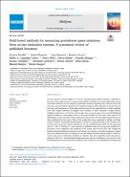| dc.contributor.author | Prativa, Poudel | |
| dc.contributor.author | Anish, Ghimire | |
| dc.contributor.author | Guy, Howard | |
| dc.contributor.author | Barbara, Evans | |
| dc.contributor.author | Miller, Camargo-Valero A. | |
| dc.contributor.author | Freya, Mills | |
| dc.contributor.author | Olivia, Reddy | |
| dc.contributor.author | Subodh, Sharma | |
| dc.contributor.author | Sarana, Tuladhar | |
| dc.contributor.author | Abraham, Geremew | |
| dc.contributor.author | Kenan, Okurut | |
| dc.contributor.author | Baba, Ngom | |
| dc.contributor.author | Manish, Baidya | |
| dc.contributor.author | Sheila, Dangol | |
| dc.date.accessioned | 2023-10-24T10:27:27Z | |
| dc.date.available | 2023-10-24T10:27:27Z | |
| dc.date.issued | 2023-04 | |
| dc.identifier.citation | Poudel, P., Ghimire, A., Howard, G., Evans, B., Camargo-Valero, M. A., Mills, F., ... & Dangol, S. (2023). Field-based methods for measuring greenhouse gases emissions from on-site sanitation systems: A systematic review of published literature. Heliyon. | en_US |
| dc.identifier.uri | https://hdl.handle.net/20.500.12504/1470 | |
| dc.description.abstract | On-site sanitation systems (OSS) are a source of greenhouse gas (GHG) emissions. Although ef-
forts have been made recently to measure and quantify emissions from septic tanks using various
field-based methods, the vast majority of published literature reporting GHG emissions from OSS
units (e.g., pits and tanks) is based on non-empirical evidence. This systematic review presents an
overview and limitations of field-based methods used for the quantification of GHG emissions
from OSS. Papers published in English were searched in three databases: Google Scholar,
PubMed, and Directory of Articles and Journals. Peer-reviewed papers that reported field-based
methods applied to containment units in OSS were included in this study. Only eight out of
2085 papers met the inclusion criteria with septic tanks as the sole technology reported and were
thus, considered for the review. Most of the studies have been conducted in middle- and high-
income countries. Field-based measurements of GHGs are conducted using a flux chamber (FC)
and the most commonly used FC methods are (a) the modified simple static FC, (b) automated
static FC, and (c) floating FC. Data reported in published studies do not provide sufficient in-
formation on the calibration and validation of the results from the FCs used. The complex FC
designs, laborious fieldwork operations, and reliance on expensive, specialist equipment, suggest
that such methods may not be suitable in Low and Middle-Income countries (LMICs), where re-
sources and access to laboratory facilities are limited. Also, the complexity of pits and tank ty-
pology in LMICs (i.e., unstandardised designs and sizes) may be a challenge to the use of FCs with
fixed dimensions and set operational conditions. The variation in the quantification methods and resulting emission rates among the studies indicates that gaps prevail in the use of existing
methods. Therefore, there is still a need for a simple field-based, easily adaptable FC method with
adequate calibration and validation that can help in reliably quantifying the emissions from
different OSS in any LMICs. | en_US |
| dc.language.iso | en | en_US |
| dc.publisher | Heliyon | en_US |
| dc.subject | Greenhouse gas emissions | en_US |
| dc.subject | Onsite sanitation | en_US |
| dc.subject | Pit latrines | en_US |
| dc.subject | Septic tanks | en_US |
| dc.title | Field-based methods for measuring greenhouse gases emissions from on-site sanitation systems: A systematic review of published literature | en_US |
| dc.type | Article | en_US |

